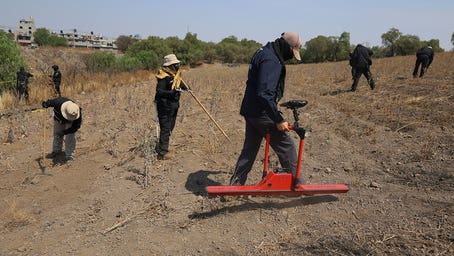Amidst the drought conditions in Brazil, a captivating discovery has been made: ancient rock carvings of human faces have been unveiled near the Amazon River. Additionally, in Poland, explorers have stumbled upon an extraordinary trove of ancient artifacts, including counterfeit Roman coins dating back to the 2nd and 3rd centuries. These finds shed light on the rich cultural heritage of both regions and provide valuable insights into the lives of our ancestors.
## Article:

Uncovering the Enigmatic Past: Ancient Carvings and Roman Treasure Trove Unearthed in Brazil and Poland
As the Amazon River experiences severe drought conditions, a previously hidden treasure has been revealed. Scattered along the riverbanks are ancient rock carvings depicting human faces. These enigmatic carvings have captured the attention of archaeologists and historians, eager to decipher their significance.
The discovery offers a glimpse into the lives of ancient civilizations that inhabited the Amazon region. The carvings are believed to date back thousands of years, possibly created by indigenous tribes as a form of artistic expression, spiritual ritual, or territorial marking.

Uncovering the Enigmatic Past: Ancient Carvings and Roman Treasure Trove Unearthed in Brazil and Poland
Experts are now undertaking detailed studies of the carvings to determine their exact age, purpose, and cultural context. The findings promise to provide valuable insights into the rich and diverse history of the Amazon basin.
In a fortuitous turn of events, a group of explorers in Poland stumbled upon a hidden cache of ancient artifacts, including a collection of counterfeit Roman coins. The discovery was made in the village of Księżpol, using metal detectors.

Uncovering the Enigmatic Past: Ancient Carvings and Roman Treasure Trove Unearthed in Brazil and Poland
The coins, dating back to the 2nd and 3rd centuries, feature the faces of prominent Roman emperors such as Antonius Pius and Mark Aurelius. Among the counterfeit coins was a forgery created by the Goths from a camel culture.
Archaeologists believe that the coins may have been part of a trade route, as they also found evidence of other ancient artifacts, including fibules, knives, and various tools. The discovery sheds light on the extent of Roman influence in Central Europe and the interconnectedness of ancient civilizations.

Uncovering the Enigmatic Past: Ancient Carvings and Roman Treasure Trove Unearthed in Brazil and Poland
The counterfeit coins found in Księżpol provide valuable insights into the practices of ancient counterfeiters. Experts believe that the Goths likely created the forgeries to mimic genuine Roman coins, exploiting their value in trade.
The study of these counterfeits offers a glimpse into the economic and social dynamics of the ancient world. Counterfeiting has existed throughout history, proving that even in ancient times, individuals sought to profit from the value of currency.
Alongside the Roman coins, the explorers also unearthed a fragment of a coin featuring the image of Herenia Etruscilla, the wife of Roman Emperor Trajan Decius. The discovery suggests that different cultural influences converged in Poland during the ancient era.
Other artifacts found in the area, such as silicon tools, pottery, and ceramics, span various historical periods from the Early Middle Ages to the Modern Period. These findings indicate a continuous human presence in the region throughout history.
The ancient artifacts discovered in Brazil and Poland highlight the importance of preserving and studying our cultural heritage. These findings provide tangible evidence of the rich and complex societies that existed in both regions.
Archaeological research is essential to unraveling the mysteries of the past and understanding the cultural tapestry that has shaped our present. By safeguarding and interpreting these ancient artifacts, we gain invaluable insights into the lives and beliefs of our ancestors.










